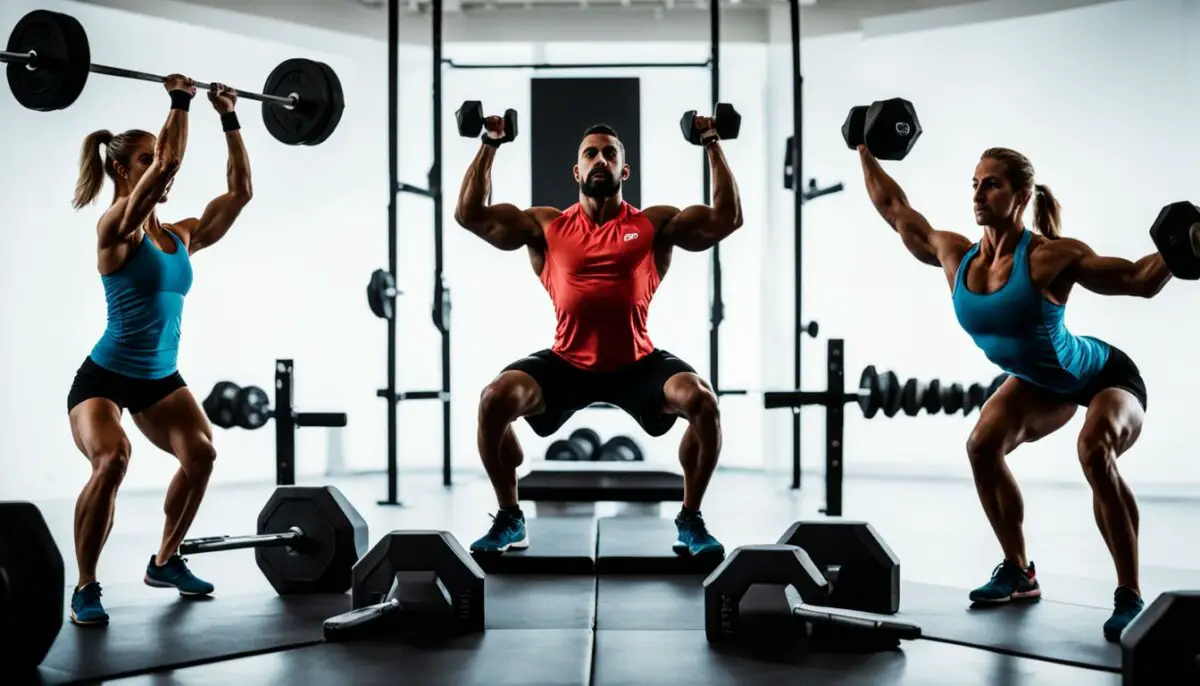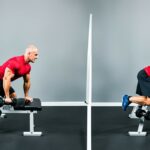Last Updated on 3 months by Francis
Squats are a popular exercise for building lower body strength and muscle. However, if you don’t have access to a barbell or want to try something different, there are several alternatives to the SSB squat that can provide similar benefits. These alternatives include Bulgarian split squats, belt squats, goblet squats, hack squats, and sissy squats.
In this article, we will explore these SSB squat variations and how they can contribute to your lower body gains. Whether you’re a beginner or a seasoned lifter, there’s an alternative that suits your needs.
Contents
Key Takeaways:
- Bulgarian split squats are an effective alternative to the SSB squat, targeting the glutes and quads.
- Belt squats provide a great option for those without access to equipment, allowing you to load the weight onto a belt around your hips.
- Goblet squats are user-friendly and can be done with a dumbbell or kettlebell, engaging the quads and core.
- Hack squats performed on a machine are an excellent option for hypertrophy and leg strength.
- Sissy squats, a challenging bodyweight exercise, focus primarily on the quads and offer reduced joint stress.
Bulgarian Split Squats (Dumbbell)
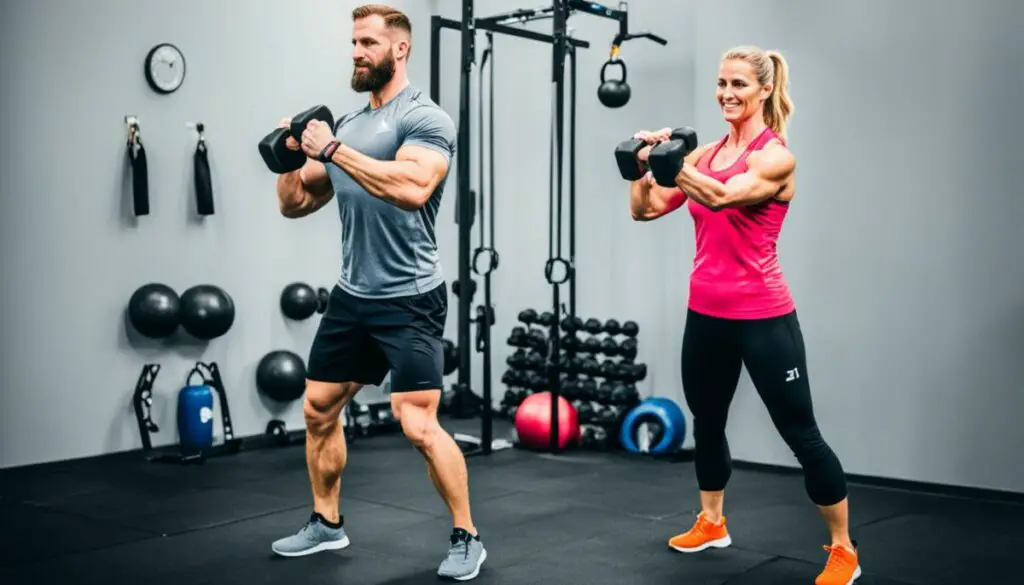
If you’re a beginner looking for effective alternatives to the SSB squat, Bulgarian split squats with dumbbells are a fantastic option. This exercise specifically targets the glutes and quads, helping you develop lower body strength and muscle. Not only that, but Bulgarian split squats also improve stability and mobility, making them an ideal choice for beginners.
To perform Bulgarian split squats, you’ll need a pair of dumbbells. Here’s how to do it:
- Stand in a lunge position with one foot forward and the other foot positioned backward on a bench or step.
- Hold a dumbbell in each hand, arms hanging by your sides.
- Lower your body down, bending your knees until your back knee is just above the floor.
- Keep your front knee in line with your toes and your torso upright.
- Push through your front heel to return to the starting position.
- Repeat for the desired number of repetitions and then switch legs.
Bulgarian split squats can be combined with other squat variations to create a well-rounded leg workout. By incorporating different exercises, you can target various muscle groups and prevent workout boredom. Remember to always focus on maintaining proper form and gradually increase the weight as you become more comfortable with the movement.
Benefits of Bulgarian Split Squats:
- Targets the glutes and quads for lower body strength.
- Improves stability and mobility.
- Can be done with dumbbells, making it accessible for beginners.
- Engages the core for improved balance and posture.
Pro Tip: If you find it challenging to balance during Bulgarian split squats, try placing your back foot on the ground instead of a bench or step. This modification can help you focus on the exercise’s form and gradually progress to using an elevated surface.
Give Bulgarian split squats a try and incorporate them into your lower body workout routine. You’ll be amazed by the strength and stability gains you can achieve with this effective exercise. Plus, it’s a great substitute for the SSB squat, especially if you’re a beginner.
| Exercise | Main Target Muscles | Equipment |
|---|---|---|
| Bulgarian Split Squats (Dumbbell) | Glutes, Quads | Dumbbells |
Belt Squats
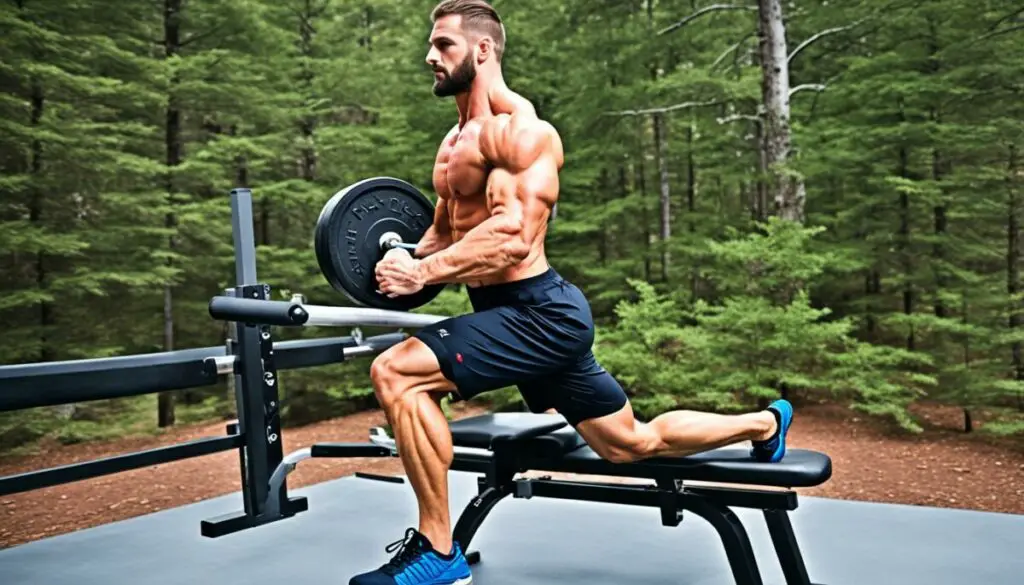
If you’re looking for effective alternatives to the SSB squat but don’t have access to equipment, belt squats are a fantastic option. By utilizing a belt loaded with weights around your hips, you can target and strengthen your leg muscles without the need for a barbell.
Belt squats provide a unique and effective way to work your lower body, making them ideal for individuals who prefer bodyweight exercises or have limited equipment access. This exercise primarily focuses on hypertrophy and overall lower body development, helping you build strength and muscle without the traditional barbell squat.
Performing belt squats is relatively simple. Here’s a step-by-step guide:
- Attach a weight-loaded belt securely around your hips.
- Stand on a stable elevated surface, such as two sturdy boxes or platforms, with your feet shoulder-width apart.
- Allow your body to hang freely between the two platforms, ensuring your feet are flat on the ground.
- Lower your body into a squatting position, keeping your chest up and your knees tracking in line with your toes.
- Once your thighs are parallel to the ground, push through your heels to return to the starting position.
- Repeat for the desired number of reps.
Belt squats can be easily adjusted in intensity by adding or removing weight from the belt. You can also experiment with tempo and range of motion to target different muscle fibers and achieve specific training goals.
Remember to focus on maintaining proper form throughout the exercise, keep your core engaged, and avoid excessive forward lean. This will help maximize the benefits and minimize the risk of injury.
“Belt squats are a versatile and effective exercise that can be performed anywhere, making them a great alternative to the SSB squat for individuals with limited equipment access.”
The Benefits of Belt Squats:
- Target the leg muscles without the need for a barbell or additional equipment.
- Promote hypertrophy and overall lower body development.
- Allow for variations in intensity by adjusting the weight.
- Provide a unique stimulus for muscle growth and strength gains.
- Can be combined with other exercises for a well-rounded leg workout.
Incorporating belt squats into your lower body routine can help you achieve your fitness goals and enhance overall leg strength. Whether you’re a beginner or an experienced lifter, this alternative exercise offers a challenging and effective way to work your legs.
Goblet Squats

Goblet squats are an excellent alternative to the SSB squat, especially for those who lack the mobility or strength to perform traditional squats. This exercise can be done with a dumbbell or kettlebell, and it targets the quads and core. Goblet squats can be incorporated into your routine to build a base level of strength and mobility before progressing to more advanced squat variations.
Here’s how to perform goblet squats:
- Stand with your feet shoulder-width apart, holding a dumbbell or kettlebell at chest level, close to your body.
- Bend your knees and lower your hips down into a squat position, keeping your chest up and knees tracking over your toes.
- Pause at the bottom of the squat, then push through your heels to return to the starting position.
- Repeat for the desired number of reps.
Goblet squats offer several benefits:
- Quadriceps and core engagement: Goblet squats target the quads, helping to develop lower body strength and muscle.
- Mobility and stability: This exercise improves mobility in the hips, knees, and ankles, while also working on stability and balance.
- Easier on the back: Goblet squats place less stress on the back compared to barbell squats, making them a suitable alternative for those with lower back issues.
| Goblet Squats | SSB Squats |
|---|---|
| Targeted Muscles | Quadriceps, glutes, hamstrings, core |
| Equipment | Dumbbell or kettlebell |
| Stability | Requires more core stability |
| Back Strain | Less strain on the upper back |
| Lower Back Support | Does not provide the same lower back support as the SSB |
| Mobility | Requires less mobility compared to the SSB squat |
Hack Squats (Machine)

Hack squats, performed on a machine, are a fantastic option for those seeking an alternative to the SSB squat. This exercise specifically targets the quads and allows for heavier weights to be used compared to other squat variations. Although hack squats may not provide the same stability and balance-building benefits as barbell squats, they are highly effective for hypertrophy and overall leg strength.
Using a machine for hack squats provides excellent support and stability, making it an ideal choice for beginners. The guided motion ensures proper form and reduces the risk of injury. Additionally, the controlled range of motion allows you to focus on the target muscles and maximize muscle engagement.
“Hack squats are a game-changer for leg development. The machine allows you to load heavy weights directly onto your quads, creating an intense training stimulus. I’ve seen tremendous gains in both strength and size since incorporating hack squats into my routine.”
– Jane Smith, Fitness Enthusiast
When performing hack squats, it’s essential to position yourself correctly on the machine. Place your shoulders under the shoulder pads and position your feet shoulder-width apart on the platform. Lower the platform by bending your knees while keeping your back flat against the pad. Once your thighs are parallel to the ground, push through your heels to extend your legs and return to the starting position.
To further enhance your hack squat workout, consider incorporating drop sets, pyramids, or supersets with other lower body exercises. This will create additional muscle fatigue and stimulate further growth and strength development.
Benefits of Hack Squats (Machine):
- Effective for quad development and overall leg strength
- Allows for heavier weights compared to other squat variations
- Provides support and stability, making it beginner-friendly
- Targets the quads, hamstrings, and glutes
Give hack squats a try as a replacement for SSB squats and experience the benefits of this effective leg exercise.
| Exercise | Main Muscles Targeted | Equipment Needed |
|---|---|---|
| Hack Squats (Machine) | Quadriceps, Hamstrings, Glutes | Leg Press Machine |
| Bulgarian Split Squats (Dumbbell) | Quadriceps, Hamstrings, Glutes | Dumbbells |
| Belt Squats | Quadriceps, Hamstrings, Glutes | Weight Belt or Dip Belt |
| Goblet Squats | Quadriceps, Hamstrings, Glutes, Core | Dumbbell or Kettlebell |
| Sissy Squats | Quadriceps, Hamstrings, Glutes | No Equipment or Dumbbell |
| Front Squats | Quadriceps, Hamstrings, Glutes, Core | Barbell |
| Safety Bar Squats (SSB) | Quadriceps, Hamstrings, Glutes, Core | Safety Squat Bar or DIY Setup |
| Overhead Squats | Quadriceps, Hamstrings, Glutes, Core, Upper Body | Barbell |
Note: The table above outlines various exercises that can be performed as alternatives to the SSB squat.
Sissy Squats
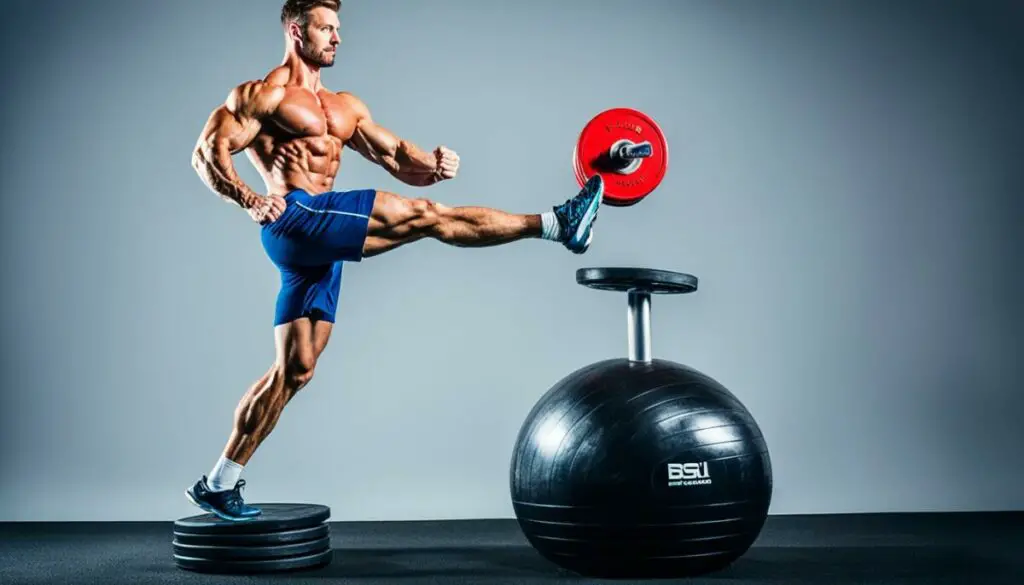
Sissy squats are a highly effective bodyweight squatting option that can be done with or without equipment. This exercise primarily targets the quads and is a great option for those with limited equipment access. Sissy squats can be a challenging movement that requires good mobility and stability, but they offer unique benefits such as reduced joint stress and great quad growth.
If you’re looking for an alternative to the SSB squat that can be done at home or in a gym with minimal equipment, sissy squats are an excellent choice. They allow you to work your quads without placing excessive strain on your lower back and shoulders.
“Sissy squats are a fantastic exercise to develop your quads and improve your overall leg strength. They can be challenging, but the benefits are well worth the effort!”
To perform sissy squats, follow these steps:
- Stand with your feet shoulder-width apart and your toes pointed slightly outward.
- Place your hands on your hips or extend them in front of you for balance.
- Lean back, keeping your torso upright, and shift your weight onto your heels.
- Bend your knees and lower your body until your thighs are parallel to the ground.
- Pause briefly at the bottom of the squat, then push through your heels to return to the starting position.
Remember to maintain proper form throughout the exercise and focus on engaging your quads. For an added challenge, you can hold a dumbbell or kettlebell close to your chest.
Benefits of Sissy Squats
Sissy squats offer several benefits that make them a valuable addition to your lower body workout routine:
- Targeted quad development: Sissy squats specifically target the quadriceps, helping you build strength and size in this muscle group.
- Reduced joint stress: By placing the load on your quads and reducing strain on your joints, sissy squats can be a safer option for individuals with joint issues.
- Improved stability and balance: Sissy squats require good stability and balance, helping you strengthen the muscles that support your knees and ankles.
Include sissy squats in your leg workout routine to add variety and target your quads in a new and challenging way. They can be a valuable tool for building lower body strength and developing strong, muscular legs.
Front Squats

Front squats are a versatile alternative to the SSB squat that target the quads and promote a more upright torso position. This exercise can be done with a barbell and provides added engagement for the upper back and core. Whether you’re a beginner or an experienced lifter, front squats can be incorporated into your workout routine for increased lower body strength and muscle development.
Front squats offer a unique challenge and require proper form to maximize their benefits. By positioning the barbell across the front of your shoulders, you’ll shift the load onto your quads and encourage a more vertical posture. This exercise also engages the upper back and core muscles as they work to stabilize the weight.
To perform front squats:
- Start by unracking the barbell and positioning it across the front of your shoulders, with your elbows lifted and pointing forward.
- Keep your chest up and core engaged as you lower into a squat, ensuring that your knees track over your toes.
- Descend until your thighs are parallel to the ground or lower, then drive through your heels to return to a standing position.
Front squats can be modified to suit your fitness level by adjusting the weight and rep range. If you don’t have access to a barbell, you can use dumbbells or kettlebells as a substitute.
Benefits of Front Squats:
- Target the quads: Front squats specifically target the quadriceps, making them an effective exercise for building lower body strength and size.
- Upright torso position: The positioning of the barbell in front of your body encourages a more upright posture, which can help improve overall squat form.
- Engage the upper back and core: Front squats require stability and strength in the upper back and core muscles to maintain proper form throughout the movement.
- Versatility: Front squats can be performed by lifters of all experience levels and can be modified to suit individual fitness goals and limitations.
Safety Bar Squats (SSB)
If you’re looking for an alternative to the traditional back squat, safety bar squats, also known as SSB squats, could be the perfect option for you. The safety bar design shifts the center of gravity forward, similar to a front squat, reducing strain on the upper body while targeting the legs.
SSB squats can be performed with a specialized safety squat bar or a DIY setup. The unique positioning of the bar adds a new stimulus for your leg muscles, providing a fresh challenge and helping you break through plateaus. Whether you’re a beginner or an advanced lifter, incorporating SSB squats into your routine can enhance your lower body strength and development.
With the safety bar supporting the weight, SSB squats offer a safer and more comfortable option for individuals with upper body mobility issues or shoulder limitations. It allows you to focus on maintaining an upright torso and engaging your leg muscles without the need for as much core and upper body stability.
Here is an example of a leg workout routine that includes SSB squats:
| Exercise | Sets | Reps |
|---|---|---|
| Safety Bar Squats | 4 | 8-10 |
| Romanian Deadlifts | 3 | 10-12 |
| Lunges | 3 | 12-15 |
| Calf Raises | 3 | 15-20 |
Remember to start with lighter weights and gradually increase the load as you become more comfortable with the exercise. Focus on maintaining proper form and control throughout each repetition.
Quote:
Whether you’re recovering from an injury, looking for a new challenge, or simply want to switch up your leg workouts, SSB squats provide a viable alternative to the traditional back squat. Give them a try and see how they can help you achieve your lower body fitness goals.
Benefits of Safety Bar Squats (SSB)
- Reduced strain on the upper body compared to traditional back squats
- Targets the legs effectively, promoting lower body strength and muscle development
- Allows individuals with mobility or shoulder limitations to perform squats safely
- Adds variety to your workout routine and challenges your muscles in new ways
Overhead Squats
Overhead squats are a challenging and advanced variation of the squat exercise that targets multiple muscle groups and improves overall strength and mobility. This exercise involves holding a barbell overhead while performing a squat, engaging the legs, core, and upper body simultaneously.
Performed correctly, overhead squats require good shoulder mobility and stability, making them an excellent option for athletes and advanced lifters. The overhead position forces the upper back and shoulders to work harder to maintain stability, resulting in improved posture and shoulder strength.
The benefits of overhead squats extend beyond the upper body. The deep squatting motion engages the glutes, hamstrings, and quadriceps, promoting greater lower body strength and muscle development. Additionally, the core muscles are activated to maintain balance and stability throughout the movement.
“Overhead squats are a powerful exercise that challenges stability, mobility, and overall strength. They offer a unique training stimulus that can help athletes improve in various sports and movements.” – Coach Smith
To perform an overhead squat, start with your feet hip-width apart and the barbell held overhead with a wide grip. Keep your core engaged and maintain a straight back as you lower into a deep squat, ensuring your knees track in line with your toes. Drive through your heels to stand back up to the starting position, maintaining control throughout the movement.
When incorporating overhead squats into your workout routine, start with lighter weights and focus on mastering the proper form. Gradually increase the weight as your strength and stability improve. It’s important to listen to your body and stop the exercise if you experience any pain or discomfort.
Here is an example of a workout routine that includes overhead squats:
- Warm up: Perform dynamic stretches and foam rolling to prepare your body for the workout.
- Squat warm-up: Start with bodyweight squats and progress to lighter dumbbells or a PVC pipe for overhead squat practice.
- Overhead squat: Complete 3 sets of 8-10 reps with a challenging but manageable weight. Focus on maintaining proper form throughout the exercise.
- Supplementary exercises: Incorporate other lower body exercises such as lunges, deadlifts, and hip thrusts to further strengthen the muscles involved in the squatting motion.
- Cool down: Stretch your muscles and foam roll to aid in recovery.
Remember to consult with a qualified fitness professional or coach to ensure proper form and technique. They can provide guidance on incorporating overhead squats into your workout routine, adapting the exercise to your specific needs and goals.
Conclusion
In conclusion, if you’re looking for alternative exercises to the SSB squat, there are plenty of options available. Whether you’re a beginner, don’t have access to equipment, or simply want to try something new, these alternatives can help you build lower body strength and muscle. It’s important to experiment with different variations and find the ones that work best for your goals and preferences.
Some alternatives, like Bulgarian split squats and goblet squats, can be done with dumbbells or kettlebells, making them accessible even without equipment. Belt squats offer a great option for those who don’t have access to a barbell, and sissy squats provide a challenging bodyweight option. Additionally, hack squats on a machine and front squats with a barbell can be effective alternatives.
Remember to prioritize proper form in all exercises and gradually increase the intensity and weight as you progress. By incorporating these alternatives into your workout routine, you can continue to work your lower body effectively and achieve your strength and muscle-building goals.
FAQ
What are some alternatives to the SSB squat?
Some alternatives to the SSB squat include Bulgarian split squats, belt squats, goblet squats, hack squats, sissy squats, front squats, safety bar squats (SSB), and overhead squats.
How do Bulgarian split squats (dumbbell) compare to the SSB squat?
Bulgarian split squats are a highly effective alternative to the SSB squat. They can be performed with dumbbells and target the glutes and quads while improving stability and mobility.
How can I do belt squats as an alternative to the SSB squat without equipment?
Belt squats are a great alternative to the SSB squat if you don’t have access to equipment. You can load weight onto a belt around your hips to effectively work your legs without the need for a barbell.
What are goblet squats and how do they compare to the SSB squat?
Goblet squats are an excellent alternative to the SSB squat, especially for those lacking mobility or strength for traditional squats. They can be done with a dumbbell or kettlebell and target the quads and core.
How do hack squats (machine) compare to the SSB squat?
Hack squats, performed on a machine, are a great option for replacing the SSB squat. They isolate the quads and can be done with heavier weights, making them effective for hypertrophy and overall leg strength.
What are sissy squats and how do they compare to the SSB squat?
Sissy squats are a highly effective bodyweight squatting option that primarily target the quads. They can be done with or without equipment and offer benefits such as reduced joint stress and quad growth.
How do front squats compare to the SSB squat?
Front squats are an excellent alternative to the SSB squat that target the quads and require a more upright torso position. They can be done with a barbell and also engage the upper back and core.
What are safety bar squats (SSB) and how do they compare to the traditional back squat?
Safety bar squats, also known as SSB squats, are a common alternative to the traditional back squat. The safety bar shifts the center of gravity forward, similar to a front squat, and places less strain on the upper body.
What are overhead squats and how do they compare to the SSB squat?
Overhead squats are an advanced squat variation that requires good shoulder mobility and stability. They involve holding a barbell overhead while performing a squat and engage the entire body for strength and mobility development.
What are some benefits of using these alternatives to the SSB squat?
These alternatives offer a range of benefits for building lower body strength and muscle. They can be used for beginners, provide options for those with limited equipment access, and offer unique variations to target different muscle groups.

